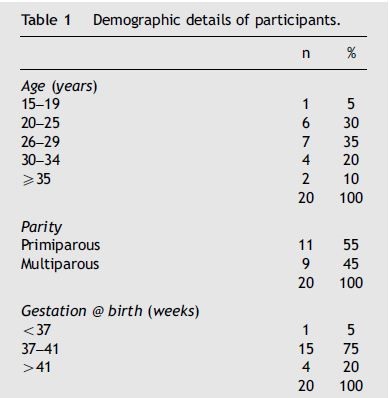Understanding Methodology: The Basics of Sampling
By: Andrea D. Lythgoe, LCCE | 0 Comments
In this third series on Understanding Research, we will take a basic look at methodologies that are used in research. Both qualitative and quantitative approaches will be explored, with discussion on the reasons different approaches might be used and the strengths and weaknesses of each. Hopefully this will help you to better understand why the methodologies matter and what you should consider as you read research that helps you to teach and share evidence-based information on topics of maternal and infant health. The first post in the Understanding Methodology can be found here. Today we discuss the basics of sampling. If you would like to review what Andrea has discussed on the blog in the past, to refresh your understanding, please click here. - Sharon Muza, Community Manager

© http://flic.kr/p/74iP1Y
Every study, qualitative or quantitative, uses a sample. The sample can be a group of people, a selection of data or a collection of laboratory specimens. For the purposes of this article, we will be focusing on a sample of people, but the same concepts apply to other kinds of samples as well.
A good study sample needs to have two qualities:
1. Sufficient size to get statistically significant results. Researchers often do a power analysis to calculate what that is. The number of variable studied, the desire for subgroup analysis, and projected dropout rate are all factored in.
2. The sample should closely match the wider population the study addresses. For example, a study on first time moms should have a sample that has a similar makeup in terms of age, ethnicity, marital status, etc. Many studies will have a table comparing their sample to the wider population.
Occasionally, researchers are able to conduct research on the entire population when the population is small enough. These samples are called "cohort samples." This is only logistically possible when the population is fairly small. Most of the time, researchers must use a smaller sampling of the larger population in the study.
How the researcher chooses their sample has a great deal to do with the external validity of the study. Wider samples that match the general population have application for working with the general population, but may miss some very important distinctions found in subgroups. Some research will use a wide sample with demographics similar to the general population but also do analysis of subgroups to try and find some of those distinctions. It takes a much larger study population to be able to tease out significant results in subgroups.
In research terms, a population is the group of everyone with the same characteristic. All pregnant women in the United States is one population, but another might be teen moms living in Rhode Island. The researcher can define the population any way they would like for the purposes of the study.
The way that the researcher recruits and selects the sample is important. Some of the major ways in which a researcher might select a sample are:
Convenience sampling - The researcher might survey the women they teach in their childbirth classes, the women who deliver at the hospital where they work, call for volunteers, or ask friends and family to participate. This is commonly used, but also can be problematic since people who already share one connection may have others that can influence the study, and their shared characteristics might make them different from the general population.
Simple random sampling - A basic method where every person in the population has an equal chance of being included in the study. This can be done by assigning each person who meets eligibility criteria a number and using a random number generator to choose which ones will be included in the study.
Stratified sampling - This method makes sure that there is representation from all segments of the population. So the researcher may choose to find a sample with 500 pregnant women who live in an urban setting, 500 women who live in a suburban setting, and 500 pregnant women who live in a rural setting. It can be combined with either random sampling or convenience sampling to get those numbers, but the idea is that the researcher makes the effort to have a sample that covers various subpopulations. The researcher may also choose to have the sizes of each group proportionate to the size of the group in the general population.
Cluster sampling - In this method, the researcher randomly chooses groups from the population and then samples from those groups. So a researcher looking at how childbirth classes change confidence levels might compile a list of all the childbirth education courses taught in their county and randomly choose 1/3 of them to be included in the study. The women in those courses would then be surveyed.
The size of the sample studied will vary widely, but is an important factor. For qualitative research, where the researcher is going into depth about the subjects, smaller sample sizes are common. This table from a study on drug use in pregnancy (Dowdell, 2007) looks at only twenty women.

For qualitative research, bigger is usually better in order to get good statistical results. Researchers are often trying to balance limited funding with the need to have a large enough study. The power analysis helps the researcher know how many study participants will be needed in order to find significant results. Often the study recruits more than the minimum number, because having participants drop out is a common occurrence, and the longer the study the more likely it is that participants will be lost to follow up.
Inclusion criteria (eligibility) - The characteristics that a person has that make them fit the population the researcher is studying. So for that study of pregnant teens in Rhode Island, the inclusion criteria might be "pregnant female, aged 12-17, living in Rhode Island."
Exclusion criteria - These can be things that exclude someone from being in the study in the first place, if they do not have the characteristics of the population the researcher wants to study, but it can also be things that happen during the study to eliminate them from participation. An example of this might be a woman who enters a study on induction at term but instead delivers prematurely.
Many studies will include a flowchart showing how the study sample may have changed over the time of the study. The example here shows instances of some of the more common reasons participants leave a study: they choose to withdraw, they experience complications that exclude them from analysis, or they are lost to follow up and no data is collected. (O'Sullivan, 2009)

One thing you'll want to be watchful about are pilot studies. These are small scale studies where the researchers are testing out the practicalities of the study protocol. They generally don't have sufficient numbers to draw real conclusions. I frequently hear educators discussing the PLACE study, where researchers removed the standard labor bed in favor of an alternative setup the researchers called the "ambient labor room." They discuss this study as if it proved better outcomes without the bed. By contrast, the researchers specifically state that "It was not the purpose of this pilot trial to search for clinically important differences, nor was the trial powered to do so. Tests for differences...were used for exploratory purposes only, to detect trends worthy of evaluation in a large trial." (Hodnett, 2009)
Looking carefully at the sample size and how closely it matches the population you might want to apply it to is very important in your evaluation of the study methodology. In the next post in this series, we will look at some of the more common experimental study designs.
Sources:
Creswell, J. (2009) Research Design: Qualitative, Quantitative and Mixed Methods Approaches. (3rd edition)
Dowdell, J.A., Fenwick, J., Bartu, A., Sharp, J. (2007) Midwives' descriptions of the postnatal experiences of women who use illicit substances: A descriptive study. Midwifery 25, 295 - 306.
Greenhalgh, T. (2010) How to Read a Paper: The Basics of Evidence-Based Medicine (4th ed.).
Hodnett, E.D., Stremler, R., Weston, J.A., McKeever, P. (2009) Re-conceptualizing the hospital labor room: The PLACE (Pregnant and laboring in an ambient clinical environment) pilot trial. Birth: Issues in Perinatal Care 36:2.
O'Sullivan, G., Liu, B., Hart, D., Seed, P. & Shennan, A. (2009) Effect of food intake during labour on obstetric outcome: randomised controlled trial. BMJ 338:b784. doi:10.1136/bmj.b784.
Rees, C. (2003). Introduction to Research for Midwives (2nd ed.). London. Elsevier Limited.
Published: June 26, 2013
Tags
Childbirth educationResearchMaternal Infant CareAndrea LythgoeUnderstanding MethodologiesUnderstanding Research Guest Posts